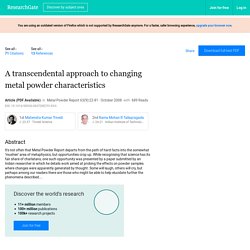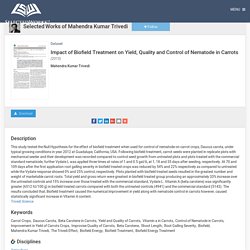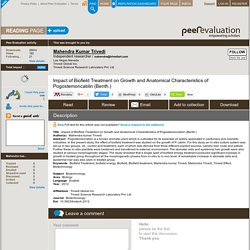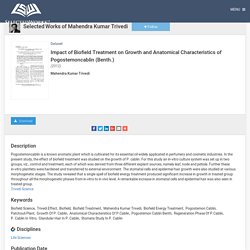

Increase in Plant Growth of Chick Pea. Study of Yield Attributes of Chick Pea. Evaluation of Yield Attributes of Mustard. Yield of Mustard & Chick Pea Seeds. Biophoton Analysis of Cashew Plant. Increase in Chlorophyll Content in Cashew Plant. Cashew RAPD Analysis. Molecular Analysis of Cashew Plant. Metal Powder Characteristics - Biofield Treatment. Atomic & Crystal Parameters of Metal Powder. Particles Size Analysis of Metal Powder. Analysis of Metal Powder Characteristics. Changing Metal Powder Characteristics. Alteration in Metal Powder Lattice Parameter. Metal-powder.net October 2008 MPR 31 density or decrease in lattice parameter is unusual.

The results raise certain unanswerable questions. As density represents weight per unit volume and as the number of atoms per unit cell are fixed by the crystal struc- ture, a decrease in density corresponds to reduced number of protons and neutrons in the nucleus and hence to a reduced weight of the atom. Density in the present experiments had resulted in a decreased charge per unit volume indicating a decrease in number of protons. Atomic weight and atomic charge on the lattice parameter is possible only if it is assumed that nuclear reactions involving protons, neutrons with neutrinos resulting. Structural Characteristics of Transition Metal Powders. Effect of Energy Treatment on Carrots. Title: Impact of Biofield Treatment on Yield, Quality and Control of Nematode in Carrots Select license: Creative Commons Attributions-NonCommercial-ShareAlike Updated: November 22nd, 2016 Abstract: This study tested the Null Hypothesis for the effect of biofield treatment when used for control of nematode on carrot crops, Daucus carota , under typical growing conditions in year 2012 at Guadalupe, California, USA.
Carrots Yield Improvement. This study tested the Null Hypothesis for the effect of biofield treatment when used for control of nematode on carrot crops, Daucus carota , under typical growing conditions in year 2012 at Guadalupe, California, USA. Following biofield treatment, carrot seeds were planted in replicate plots with mechanical seeder and their development was recorded compared to control seed growth from untreated plots and plots treated with the commercial standard nematicide, further Vydate L was applied three times at rates of 1 and 0.5 gal/A, at 1, 18 and 35 days after seeding, respectively.
At 70 and 109 days after the first application root galling severity in biofield treated crops was reduced by 54% and 22% respectively as compared to untreated while the Vydate response showed 0% and 25% control, respectively. Energy Impact on Immunity of Carrots. Description This study tested the Null Hypothesis for the effect of biofield treatment when used for control of nematode on carrot crops, Daucus carota, under typical growing conditions in year 2012 at Guadalupe, California, USA.

Following biofield treatment, carrot seeds were planted in replicate plots with mechanical seeder and their development was recorded compared to control seed growth from untreated plots and plots treated with the commercial standard nematicide, further Vydate L was applied three times at rates of 1 and 0.5 gal/A, at 1, 18 and 35 days after seeding, respectively. At 70 and 109 days after the first application root galling severity in biofield treated crops was reduced by 54% and 22% respectively as compared to untreated while the Vydate response showed 0% and 25% control, respectively. Plots planted with biofield treated seeds resulted in the greatest number and weight of marketable carrot roots. Citation Information. Increase in Vitamin-A Content in Carrots.
Nematode Control in Carrots - Biofield Treatment. Study of Daucus Carota Yield Improvement. Daucus Carota Nematode Control. Energy Treatment & Oil Yield in P. Cablin. 0WordPress0CiteULike0 New Pogostemoncablin is a known aromatic plant which is cultivated for its essential oil widely applicated in perfumery and cosmetic industries.

In the present study, the effect of biofield treatment was studied on the growth of P. cablin. For this study an in-vitro culture system was set up in two groups, viz., control and treatment, each of which was derived from three different explant sources, namely leaf, node and petiole. Further these in-vitro plantlets were hardened and transferred to external environment. The stomatal cells and epidermal hair growth were also studied at various morphogenetic stages.
Your session has expired but don’t worry, your message has been saved.Please log in and we’ll bring you back to this page. Your evaluation is of great value to our authors and readers. Review When you're done, click "publish" Only blue fields are mandatory. Your mailing list is currently empty.It will build up as you send messagesand links to your peers. P. Cablin (Patchouli) Growth. Analysis of Plantlet Regeneration in P. Cablin. Description Pogostemoncablin is a known aromatic plant which is cultivated for its essential oil widely applicated in perfumery and cosmetic industries.

Study of Pogostemon Cablin Growth. Influence of Energy Treatment on Patchouli Growth. Anatomical Characteristics of Pogostemon Cablin. In Vitro Evaluation of Patchouli (P. Cablin) Effect of Energy Treatment on Growth of P. Cablin.